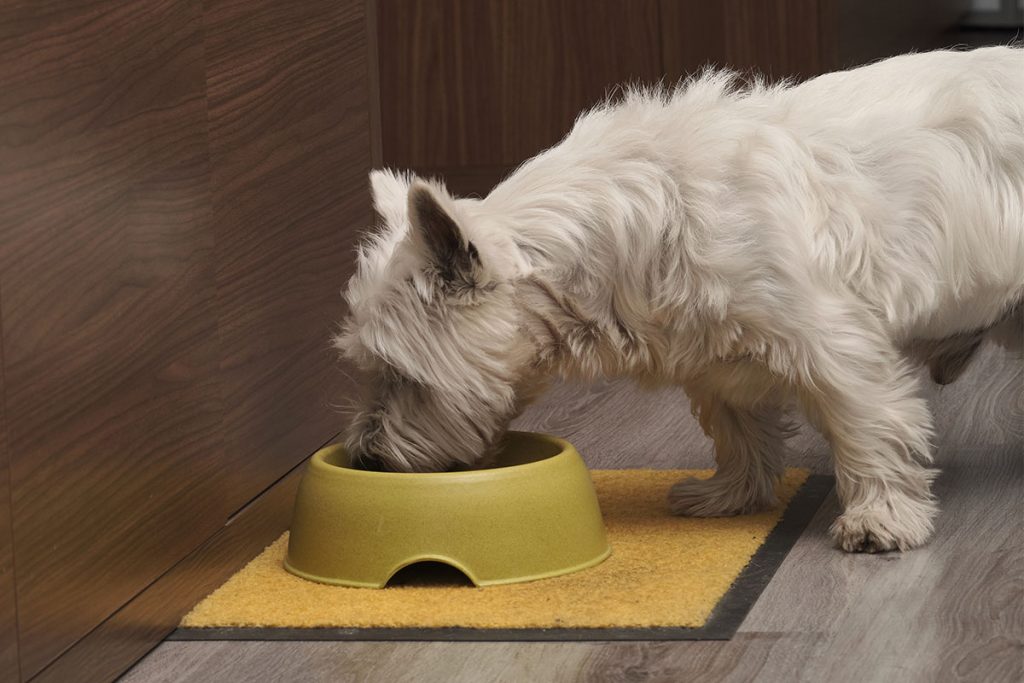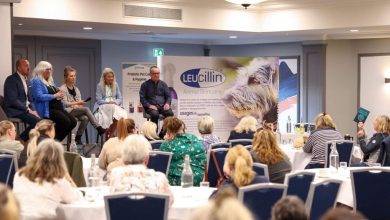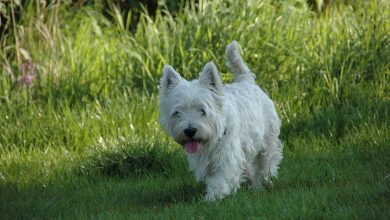Q: Firstly, why does there continue to be a disagreement among vets on the benefits and risks of raw feeding in the UK? Secondly, if vets cannot agree on the raw versus kibble debate how can the public be expected to know which is best for their dog?
A: I would like to answer these together. In my opinion vets will always have a healthy questioning of the facts laid before them and may often due to personality and circumstances which taint their point of view have differences of opinion. This is partly a reflection on how little is understood about the complexities of nutrition and the lack of understanding in these days of technology how each individual being can be different from the next. Often we naturally concentrate on similarities and in doing so loose the focus on what makes us individuals. Mammals have survived millennia through evolving to eat and digest/absorb nutrients through a variety of biological mechanisms often in times of scarcity.
Far from our canine companions being changed from their ancestral roots over a hundred years it is quite evident from their lack of ability to to masticate with a grinding action as the hinge joint of the jaw prevents side to side action in a dog, to the gut length and structure not being sufficient to break down vegetable matter with out predigestion by another animal then we can reflect that canines are still truly carnivores.
In true human fashion we believed through processing foods and using by products of food manufacture we can produce a more affordable food for all species. This has bitten us badly when we look at spongiform encephalopathies (e.g. mad cow disease) due to the feeding of processed animals into cattle feed to increase protein and even for our own health with processed ready meals leading to a huge rise in obesity and chronic inflammatory disease and even cancer. Recent years have revealed that the best way to combat these issues are to look back to more whole foods and appropriate feeding of our animals and ourselves.
But still we see processed foods on the shelves for both and this I feel is no more scientific than it is socioeconomic. It is purely our greed for lower cost and convenience that drives our desire for processed foods. Political and marketing arguments develop around protecting markets and income and often are traceable to vested interests and ultimately income. I wish I could honestly say that health was at the core of what we eat but I feel our food landscape would be an entirely different vista than that we see today. However I hope that a growing number of dog owners are seeing a glimpse of the future and in just the last 20 years we have seen owners naturally shifting their own eating habits and that of their dogs from less than one percent of the pet food industry to more than 10 percent and it continues to grow exponentially even in the face of abuse from highly processed food companies backing.
Q: How much training do vets have on nutrition whilst studying to become a vet?
A: Vets have 5 years of training much of which in the first two years historically has been firmly grounded in anatomy (the study of body structure and species differences), physiology (the study of the bodies reactions and mechanisms to respond to its environment ) and biochemistry (the study of how the body uses the nutrients and processes them to build, repair and produce energy to function). Then over the next three years the study of diseases and the affects they have on a multitude of species and the support the patient needs to heal.
Nutrition is often seen separately from these processes by many people recommending how to feed your pet having gained online qualifications. However they are an integral part of understanding what the body needs especially for animals which are already ill. The quotes for the study in production of foods for pet animals are often limited to no more than a few weeks and are often are funded by commercial feed companies are true still to this day and are not the independent lectures of assessing a species needs, in areas such as the five freedoms of animal welfare and the relevance of how we influence diets health impacts by using highly processed diets rather than following human health advice of move away from processed food to a wide variety of appropriate whole foods.
The RFVS defines the gold standard diet for pets as: “As close to the evolutionary diet of dogs and cats as is practically possible, is made from fresh frozen raw meaty bones, meats, organ meats, fruits and vegetables, minimally processed by mincing and freezing. The diet contains no added synthetic supplements, additives or preservatives.”
Back in the 1970s it seemed commonplace for dog-owners to literally throw their dog a bone and dogs were given leftovers from their owner’s meals.
Q: As pet owners, have we now gone backwards in terms of what we feed our dogs by moving away from fresh food?
A: This is an interesting point, over a 150 years ago there were offals and bones and poor quality meats offered up for sale cheaply as dog food but with it came the unseen risk of disease. At that time Spratts dog food was not brought about as a sanitised cheap alternative because of improved health virtues. It was born of human nature to divorce our selves from the reality of nature and so sanitise our vision whilst driving down cost with mixer biscuits using lower grade cereals, bulking agents and thus giving an air of convenience. Instead of the unknown threat of bacteria and viruses came the unknown threat of using highly processed and species inappropriate feeding.
As with many human trends the popularity of processed foods have waxed and warned over the last 100 years dependent on general wealth of the nation, marketing campaigns, drive of convenience for the time poor, and now the influence of people within social media. Indeed we all have stories to tell of what we used to feed our dogs as a childhood family (and got away with it). We have benefitted over the years of realising that using our pets as recyclers for waste food from our fridge is dangerous and should not be categorised as raw feeding. It is important to understand that what we know now is an evolution of learning from our mistakes and not a blind faith of just winding a clock back through rose tinted glasses.
For instance we have learned that increasing the use of factory farming production and processed foods means we need to use more supplements to fortify this food with otherwise naturally occurring vitamins. We see that artificially increasing palatability of foods with colours and flavourings to get our pets or our selves to eat more, of what would otherwise be a greyish dry bland material containing energy on a one size fits all basis, can lead to excessive consumption of calories and a growing obesity crisis. Let alone increasing what are known factors in prevalence of cancers and immune mediated disease.
We have learnt over the years that using medicines, pesticides and herbicides although increasing yields can have health implications not just for us but also for our pets. Just a couple of examples are the legal action over Glyphosate herbicides and the misuse of antibiotics in our production animals. These residues and consequences of use can persist far from harvest but onto our tables and food dishes.
So I believe we have learnt that a move away fresh species appropriate feeding is a move away from a healthier diet.

Q: Why do you think some dog owners fear raw feeding?
A: Most dog owners accept they own a pet carnivore (their teeth cannot grind vegetable matter, their gut is too short to give time to bacterial fermentation for any meaningful release of energy and nutrients from whole plant matter). So I think in this modern age we have been raised to fear all micro organisms. They are portrayed as the death of civilisations, used as weapons in germ warfare, and creators of health hazards from food poisonings to Coronavirus Covid-19. So in this age of scares and risk aversion vested interests will use this to drive a population towards their product. Now don’t get me wrong there are circumstances where washing your hands and using clean instruments can stop a whole heap of problems. However we must realise that actually we co exists with a much more complex relationship of symbiotic microorganisms which far from being an enemy are actually vital for a healthy life.
Secondly is the fear we will get the dietary balance and nutrition wrong. When we consider the importance of our canine companions to be part of the family I am amazed at the success of the propaganda that we do not worry more about feeding our own human children. It is right that for decades we as a profession have laboured under a notion that balanced nutrition should be complete in every bite. And that this scientific optimum has been worked out by NRC, AAFCO, and FEDIAF for the manufacture of processed diets. This actually has borne out to be far from the truth and ignores some vital bits of information. Many of the constituents in the guidelines are only accurate if you are using cooked processed foods. The nutrient to calorie ratio cannot be a one size fits all as we all use energy at different rates and depending on circumstances of age, growth, injury or disease need nutrients in differing amounts. Some nutrients especially minerals compete with each other to be absorbed from the gut into the body so feeding them together doesn’t optimise nutrition. Mammals (in fact all life) has developed mechanisms through evolution to optimise the feast and famine circumstances of the world we live in. The fact there is a seasonality to our lives as sure as the world rotates and travels round the sun means we must adapt or perish. So life’s biology has developed mechanisms of active transport and osmosis, not just diffusion to absorb nutrients often released by appropriate digestion. This means that variety is our saviour when we need to absorb different nutrients.
So we need to help dog owners know what their responsibilities are under animal welfare five freedoms are when keeping any animals including dogs. This then means they need to embrace the beneficial and protective nature of the microbiome and differentiate what are true pathogens (disease causing bugs) Secondly that real balance as with our own diet is achieved through appropriate variety and doesn’t have to be conveniently served up as constant set of inaccurate parameters.
Q: Do you think people are worried about feeding raw meat or is it that they are concerned about the cost and perhaps they feel raw feeding is too complicated?
A: The concerns over the sanitised world we live in is partly exemplified by human natures response to the Coronavirus COVID-19 pandemic. When we kept the message simple even though it was inaccurate and incomplete (“Stay at home, Save Lives, Help the NHS” oh and “wash your hands”) we saw 80-90% understanding and compliance even though it impacted on our liberties and quality of life. As soon as we start to try to explain elements of what are important to maintain protection and introduce other measures such as face covering and reveal that science isn’t all black and white, yet return to some normality we see as little as 10-15% understanding and compliance. We can only start people understanding the truth about how to live healthy lives when then experience a personal need. Then trying to engage them in a clear path giving simple examples of individuality, responsibilities as owners, impact of what we eat and knowledge of where it comes from, and lastly that using basic principles of variety that far from complex in reality feeding your dog can be simple. Of course cost of every individual item we can look at but the bigger picture of environmental, health and nutrition impact can become less expensive. This is where having a smaller breed can be just as rewarding whilst being more aware of the foot print they leave on our planet and our wallet.
Many people handle their own meat daily without any repercussions.
Q: Why is there a fear factor about handling raw food for dogs?
I think this is due to the message given by professionals being reduced to a 10 second sound bite and public health driving a message and creating research to back the preconceived message rather than being sensible. Use fresh produce clean surfaces and clean implements before and after use and wash your hands. That’s all it takes. People are even fearful of handling their own food properly due to the health and safety message. However what you don’t see is the ever increasing risk of allowing some one else in a large company a long way away to prepare your dinners and expect them to take the same level of care at a cost you are willing to pay.
Q: Do you think the mainstream press and certain vets are deliberately sabotaging raw food campaigns for their own gain in some way?
Everyone has an axe to grind and conspiracy theories rage amongst many social media forums.
The biggest travesty of the late twentieth century was our drive for convenience and losing sight of our responsibilities for the planet we live on, the species we share it with and for future generations. Marketing has responded to human nature and we have learned to streamline the truth to keep the message strong and the sales going to keep up our ability to survive and provide care for animals.
As for the press we acknowledge that they too thrive on human nature to avidly read more about threat, tragedy and strife than pleasant success and safety. So of course everyone does it for their own gain that is human nature.
To say they don’t, dehumanises them and suggests a darker motive. However professionals hold onto a pretence of science when pushing away alternative ideas which they don’t have the knowledge or time to explain.
Q: Are these same vets possibly sponsored by large corporate dog food manufacturers?
A: We should always be asking who funds what research papers, individuals, organisations or businesses that a comment may have bias towards. Science has strived to have this stated on research papers. Yet again human nature often leads to no acknowledgement that for instance a comment from the British Veterinary Association should be associated with one of their biggest sponsors which is a pet food company or that research from various professors at university residency positions are often sponsored by other pet food manufacturers. It may often be deemed not journalistically correct to write President of the BVA, Sponsored by…… All of us like to believe we are free thinking ethical scientists but we all believe a version of the truth which makes for debate. My view is obvious I currently head up the Raw Feeding Veterinary Society as their president and we are sponsored by several small manufacturers of raw food so we all have vested interests as unless members of the public start to sponsor these positions and organisations anonymously, the organisations would cease to exist or we remain with aligning ourselves to a point of view and being sponsored by those who believe in us or gaining greater funds and aligning our thoughts to those of the sponsor.
The BBC recently aired a programme on raw dog food.
Q: If you had been on the programme what vital information or research/evidence would you have shared with viewers? Do you think the programme was a fair representation of the raw versus kibble debate?
A: A full detailed personal answer was penned from a colleague and friend Dr Nick Thompson of Holistic Vet however typically to make a story the answer was severely edited. Much of the research quoted came from our position statement to be seen on the RFVS.info website. In addition some vital information from research carried out by a team at Helsinki University Veterinary department in 2019 (Anturaniemi, J., Barrouin-Melo, SM., Zaldivar-López, S., Sinkko, H., Hielm-Björkman, A.(2019) Owners’ perception of acquiring infections through raw pet food: a comprehensive internet-based survey Veterinary Record 185, 658.)
From 16 475 households, 0.2 per cent (n=39) reported having had a transmission of pathogen from the raw pet food to a human family member during the time that raw feeding had been used in the household. Only in three of those households the same pathogen that was found in the human sample was analysed and confirmed also in the raw pet food (0.02 per cent of all data). Moreover, 0.1 per cent (n=24) reported suspecting that a disease could have been transmitted to a human from the pet food. Feeding salmon and turkey, using more than 50 per cent of the diet as raw foods and preparing the raw food in the same place and utensils as the family foods all had negative association with infections. Having 2 to 6 year-old children living in the household was associated with more infections, although adults were the most frequently infected.
Translated that means its very rare to actually see the proposed risk in real life if you feed raw properly especially 80-90 percent of the diet as the cases seemed to emanate from the use of spoiled human food and left overs being fed to pets and from young children probably coming home from nursery. In fact if you feed your pets raw you are more likely to have a healthier family.
The second piece of information (as it was not a scientific paper) would be to highlight the interpretation of the very same public health England report from 2017, highlighted by the BVA president. As in fact assumptions were made that raw pet food must be a source of Shiga-toxin releasing E.Coli (STEC) and as stated it is devastating that any preventable deaths should occur the actual bacterium that lead to the fatalities were not matched exactly to any pet food tripe source but that only similar had been found. No investigations of a well known source of infection, under-washed vegetables were made. This statement has been used in many circles as scientific fact when it actual is far from the absolute proof portrayed.
We are striving to ensure that responsible raw feeding has to be the way forward and ask you to look out for those brands which are undertaking auditing from “Rawsafe” set up by RFVS to help the public find manufacturers of raw pet foods that meet the exacting standards of any caring professional. They look to ensure traceability, hygiene of ingredients and maintenance of hygiene through out manufacture and delivery to your local store or door step. We also want to help people understand how to handle their dogs food from freezer to bowl and dispel any unproven myths which are currently used to scare you back to a processed diet.
“The Raw Feeding Veterinary Society (RFVS) significantly reduces the seventeen-year knowledge gap by accessing current nutritional research and applying the principles in day-to-day practice,” according to an RFVS statement.
Q: Why is there a 17-year gap in knowledge and what are the day-to-day principles?
A: 17 years seems a long time but that is what Morris et al. – in the Journal of the Royal Society of Medicine 2011 – estimated it takes for research to actually be used in frontline practice. So although it, of course, can never be brought to zero – we should hope to be able to bring it down significantly. The advantage of raw feeding is that any knowledge and improvements can almost instantly be adopted once understood. Adaptability to our patients needs is key to being on the cutting edge of the health profession.
The day-to-day principles relate to how as a professional we up hold our oath to take responsibility for the health of the patients under our care with paramount importance being based around our patients welfare. The five welfare needs as quoted from the British Veterinary Associations Animal Welfare Foundation are ;
- the need for a suitable environment
- the need for a suitable diet
- the need to be able to exhibit normal behaviour patterns
- the need to be housed with, or apart from, other animals
- the need to be protected from pain, suffering, injury and disease
Every day we see patients and want to advise them not just what is needed to get well again but how to stay in a state of health. To this end we believe that three of these needs are helped by giving and suitably appropriate raw food diet, allowing animals to exhibit normal behaviour and space whilst eating that diet helping them remain protected from pain, suffering and disease.






